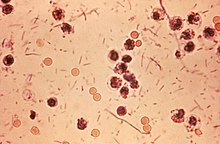| Shigellosis | |
|---|---|
| Other names | Bacillary dysentery, Marlow syndrome |
 | |
| Shigella seen in a stool sample | |
| Specialty | Infectious disease |
| Symptoms | Diarrhea, fever, abdominal pain[1] |
| Complications | Reactive arthritis, sepsis, seizures, hemolytic uremic syndrome[1] |
| Usual onset | 1–2 days post exposure[1] |
| Duration | Usually 5–7 days[1] |
| Causes | Shigella[1] |
| Diagnostic method | Stool culture[1] |
| Prevention | Handwashing[1] |
| Treatment | Drinking fluids and rest[1] |
| Medication | Antibiotics (severe cases)[1] |
| Frequency | >80 million[2] |
| Deaths | 700,000[2] |
Shigellosis (Historically the disease usually referred to as Dysentery) is an infection of the intestines caused by Shigella bacteria.[1][3] Symptoms generally start one to two days after exposure and include diarrhea, fever, abdominal pain, and feeling the need to pass stools even when the bowels are empty.[1] The diarrhea may be bloody.[1] Symptoms typically last five to seven days and it may take several months before bowel habits return entirely to normal.[1] Complications can include reactive arthritis, sepsis, seizures, and hemolytic uremic syndrome.[1]
Shigellosis is caused by four specific types of Shigella.[2] These are typically spread by exposure to infected feces.[1] This can occur via contaminated food, water, or hands or sexual contact.[1][4] Contamination may be spread by flies or when changing diapers (nappies).[1] Diagnosis is by stool culture.[1]
The risk of infection can be reduced by properly washing the hands.[1] There is no vaccine.[1] Shigellosis usually resolves without specific treatment.[1] Rest, and sufficient fluids by mouth, are recommended.[1] Bismuth subsalicylate may help with the symptoms; however, medications that slow the bowels such as loperamide are not recommended.[1] In severe cases antibiotics may be used but resistance is common.[1][5] Commonly used antibiotics include ciprofloxacin and azithromycin.[1]
A 2005 report by the World Health Organization estimated that shigellosis occurs in at least 80 million people and results in about 700,000 deaths a year globally.[2] Most cases occur in the developing world.[2] Young children are most commonly affected.[1] Outbreaks of disease may occur in childcare settings and schools.[1] It is also relatively common among travelers.[1] In the United States about half a million cases occur a year.[1]
- ^ a b c d e f g h i j k l m n o p q r s t u v w x y z aa ab ac "General Information| Shigella – Shigellosis | CDC". www.cdc.gov. 3 August 2016. Archived from the original on 16 April 2017. Retrieved 20 April 2017.
- ^ a b c d e Guidelines for the control of shigellosis, including epidemics due to Shigella dysenteriae type 1 (PDF). WHO. 2005. p. 2. ISBN 978-9241593304. Archived (PDF) from the original on 21 August 2017. Retrieved 20 April 2017.
- ^ "Factsheet about shigellosis". European Centre for Disease Prevention and Control. 8 July 2010.
- ^ Antibiotic Resistance Threats in the United States, 2019 (PDF). CDC. 2019. p. 9. Archived (PDF) from the original on 10 October 2022.
- ^ "Update – CDC Recommendations for Managing and Reporting Shigella Infections with Possible Reduced Susceptibility to Ciprofloxacin". emergency.cdc.gov. 7 June 2018. Retrieved 16 June 2018.